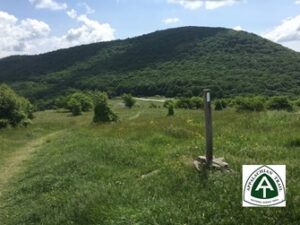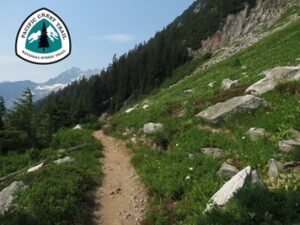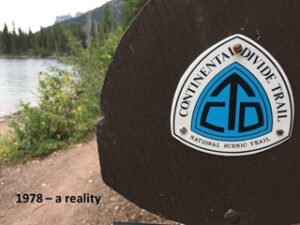By Jenny Feick, PhD
Read in The Globe and Mail: https://apple.news/ARKD6TecwThGWflUpiS9nHg
Brianna Sharpe’s Globe & Mail article in April 2022 entitled “Hikers push for Alberta’s Great Divide Trail to be given official recognition” brought to mind one of the many opinion pieces expressed during the story telling sessions that formed the backbone of the book Tales from the Great Divide, Vignettes on the Origins and Early History of Canada’s Great Divide Trail and the Great Divide Trail Association. Perhaps given the immense and growing popularity of trails during the pandemic will make federal and provincial politicians more receptive to the notion of legislation to protect national long-distance trails than they have been since the 1970s. In these sections of dialogue taken from the book, DAVE refers to Dave Higgins, JENNY to Jenny Feick (rhymes with hike), and CLIFF to Cliff White. Letters in bold indicate that the person speaking emphasized those words.
For anyone interested in reading more stories from the folks who initiated the idea of Canada’s Great Divide Trail and Great Divide Trail Association, you can still purchase a copy of the Second Edition of the book in three ways:
- Order a print-on-demand version from Amazon for Cdn $85.00 (rate in US$ varies with the exchange rate) plus shipping (free for Amazon Prime members).
- Arrange to purchase a printed copy directly in person from Jenny Feick, the editor, in the Invermere area for Cdn $65.00 (shipping anywhere in Canada would cost $20.00) by emailing jenny.feick@gmail.com.
- Order a PDF version from the Nature Wise Consulting website for Cdn $25.00 – https://naturewise.me/consulting/product/tales-from-the-great-divide-second-edition/
From Chapter Four, Pages 110-111 of Tales from the Great Divide, 2nd edition
DAVE: “…the problem in Canada is that we have no overarching legislation that relates to hiking trails. In the U.S., good old President Nixon, in 1968, 50 years ago, signed a piece of legislation called the National Scenic Trails Act[1], which allowed for immediate recognition and government support and protection of long-distance trails that were already on the ground there, of which there were several, like the Appalachian Trail, Continental Divide Trail[2], Pacific Crest Trail[3], amongst others.”
“So, the problem here [in Canada] is that these people [civil servants and politicians], with their attitudes and biases, can hold sway. In the U.S., that can’t happen now because the legislation is the main determining factor. Now Donald Trump could potentially…”
JENNY: “Annihilate it.”
DAVE: “But that’s probably well below his radar.”
CLIFF: “The Appalachian Trail. In the west, obviously most of those [long-distance trails] are on federal lands, so it’s a no-brainer, but how does it work for the Appalachian Trail where you must…”
DAVE: “In reality, the Appalachian Trail is probably 99 percent on public land.”
CLIFF: “So, state or federal?”
DAVE: “Both. The National Scenic Trails Act allowed for gradual purchase of private lands over time with the goal of it being 100 percent on public land eventually. Then we have the Bruce Trail in Ontario that’s been on the ground in various forms for over 50 years, and it has none of that. So, it’s probably 80 or 90 percent on private land for its 700 kilometres.”
JENNY: “It’s much harder.”
DAVE: “Its route [the Bruce Trail] is changing every year, because a land changes hands and the new owner says, ‘Screw that! I want them off my property.’ So, now it’s on the road, or it’s looking for some other way around it [the private land parcel where the trail used to be]…”
CLIFF: “It’s like a game of Chinese checkers for this [Great Divide] Trail, because you’ve got Alberta and BC Parks never agreeing on anything all at the same time.”
DAVE: “But it is virtually all on public land. So, you don’t have the danger of the [Great Divide] Trail being punted off of its location at a whim [of a private landowner], right?”
“But in the States, they have that with the Appalachian Trail. A lot of it was on private land, but the National Scenic Trails Act allowed it to be gradually converted. As lands came up for sale, the [federal or state] government purchased these lands. So, they’re miles ahead of us in terms of how they look at this kind of thing.”
Background
Contrary to the headline of the Globe & Mail article, the GDT is not Alberta’s trail. The GDTA is incorporated federally since the GDT is an interprovincial trail following the nationally significant watershed divide that forms the border between Alberta and British Columbia. The GDTA is a federal charitable organization. Ideally, all three governments should be recognizing the GDT and setting aside a protected corridor along the GDT route. Unlike the U.S.A., Canada lacks much-needed legislation to designate and protect national scenic long distance trails.




[1] Editor’s Note: Actually called the National Trails Systems Act, this legislation mandated the establishment, protection and management of National Scenic Trails and other types of trails. The first two National Scenic Trails were the Appalachian Trail (AT) (see Chapter 2, Footnote #9 on page 10, for a description of the AT), and the Pacific Crest Trail (PCT) (see Footnote #133 below).
[2] The Continental Divide Trail was still just an idea in 1974 and was not designated a National Scenic Trail until 1978. Read more about this in Chapter Three (see Footnote #20 on page 21).
[3] The PCT travels 2,653 mi. (4,270 km), beginning at the Mexican border and heading north along the Sierra Nevada and the Cascade Mountains, passing through California, Oregon and Washington states in the U.S.A. into Manning Provincial Park in B.C., Canada.
